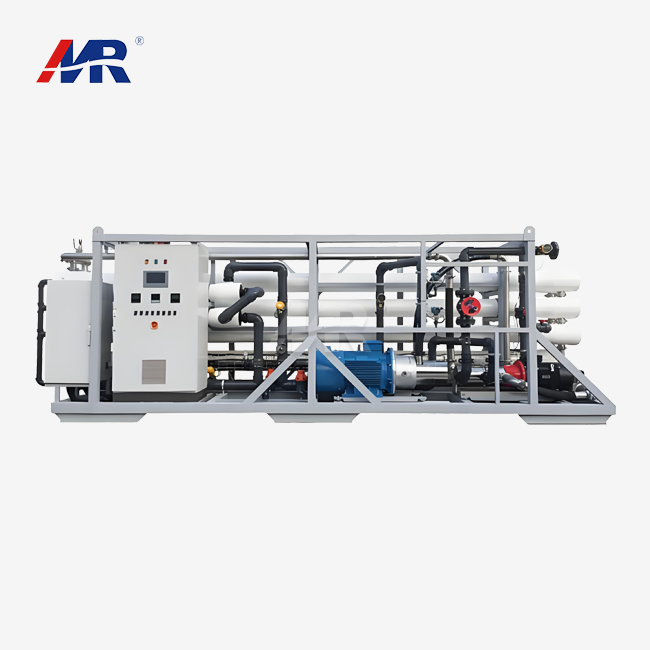Reverse Osmosis vs. Thermal Desalination: Key Process Differences
When it comes to seawater desalination, two primary methods dominate the industry: reverse osmosis (RO) and thermal desalination. Each approach has its unique characteristics and applications, making them suitable for different scenarios.
Reverse Osmosis: The Membrane-Based Approach
Reverse osmosis is the most widely adopted technology in modern SWRO plants. This process relies on semi-permeable membranes to separate salt and other impurities from seawater. Here's how it works:
- Pressure Application: Seawater is pressurized to overcome osmotic pressure.
- Membrane Filtration: The pressurized water is forced through RO membranes, which allow water molecules to pass while rejecting salt ions and other contaminants.
- Permeate Collection: The filtered freshwater (permeate) is collected for further treatment and use.
- Brine Disposal: The concentrated saltwater (brine) is discharged or further processed.
RO systems are known for their energy efficiency and ability to produce high-quality water with lower operational costs compared to thermal methods. They are commonly used in seawater desalination plants worldwide, especially in regions where freshwater resources are scarce.
Thermal Desalination: The Heat-Driven Process
Thermal desalination techniques use heat to separate freshwater from seawater through evaporation and condensation. The two main thermal processes are:
- Multi-Stage Flash (MSF) Distillation: Seawater is heated and passed through multiple stages of decreasing pressure, causing rapid evaporation (flashing) and subsequent condensation of pure water.
- Multi-Effect Distillation (MED): This process uses a series of evaporators (effects) to boil seawater at progressively lower pressures, maximizing energy efficiency.
Thermal desalination is particularly advantageous in regions with abundant low-cost thermal energy sources, such as waste heat from power plants or industrial processes.
From Seawater to Freshwater: Step-by-Step SWRO Process
The seawater reverse osmosis (SWRO) process is a multi-stage operation that transforms seawater into potable water. Understanding each step is crucial for optimizing plant performance and ensuring high-quality water production.
Intake and Pre-treatment
The journey begins with seawater intake, where careful design is essential to minimize environmental impact and ensure a steady water supply. The pre-treatment phase is critical for protecting downstream equipment and enhancing overall system efficiency:
- Screening: Large debris is removed using coarse and fine screens.
- Coagulation and Flocculation: Chemicals are added to aggregate suspended particles.
- Sedimentation: Heavier particles settle out of the water.
- Media Filtration: Sand or multimedia filters remove smaller particles.
- Microfiltration or Ultrafiltration: These processes provide an additional barrier against fine particles and microorganisms.
High-Pressure Pumping and Reverse Osmosis
The heart of the seawater desalination system lies in the reverse osmosis stage:
- High-Pressure Pumping: Pre-treated water is pressurized to 55-80 bar, depending on feed water salinity and membrane specifications.
- Membrane Separation: Pressurized water passes through semi-permeable RO membranes, typically arranged in a two-pass configuration for optimal salt rejection.
- Permeate Collection: Fresh water (permeate) is collected from the membrane elements.
- Energy Recovery: Devices such as pressure exchangers or turbines recover energy from the high-pressure brine stream, significantly reducing overall energy consumption.
Post-treatment and Remineralization
The final stages ensure that the produced water meets drinking water standards and is suitable for distribution:
- pH Adjustment: The typically acidic RO permeate is neutralized using alkaline chemicals.
- Remineralization: Essential minerals are added back to the water for taste and health benefits.
- Disinfection: Chlorination or UV treatment ensures microbial safety.
- Storage and Distribution: Treated water is stored in reservoirs and distributed to end-users.
How Does Membrane Technology Remove Salt from Seawater?
Membrane technology, particularly reverse osmosis (RO), is the cornerstone of modern seawater desalination. The process of salt removal at the molecular level is a fascinating interplay of physics and chemistry.
The Science Behind Salt Rejection
RO membranes are designed with a semi-permeable structure that allows water molecules to pass through while rejecting salt ions and other dissolved solids. This selective permeability is achieved through several mechanisms:
- Size Exclusion: The membrane's pores are small enough to block larger salt ions while allowing smaller water molecules to pass.
- Charge Repulsion: Many RO membranes have a slight negative charge, which repels negatively charged ions like chloride.
- Diffusion Control: The membrane material influences the diffusion rates of different molecules, favoring water over dissolved salts.
Advanced Membrane Materials and Configurations
Continuous advancements in membrane technology have led to more efficient and durable desalination systems:
- Thin-Film Composite (TFC) Membranes: These multi-layer membranes offer superior salt rejection and water flux.
- Nanomaterials: Incorporation of nanomaterials like graphene oxide can enhance membrane performance and fouling resistance.
- Biomimetic Membranes: Inspired by natural water channels in cell membranes, these cutting-edge materials promise higher efficiency and lower energy consumption.
Membrane configuration also plays a crucial role in system performance. Spiral-wound elements are the most common in SWRO plants, offering a balance of efficiency and practicality. However, hollow fiber and flat sheet configurations are also used in specific applications.
Overcoming Challenges in Membrane Desalination
While membrane technology has revolutionized seawater desalination, several challenges persist:
- Membrane Fouling: Accumulation of particles, organics, and biological growth on membrane surfaces can reduce efficiency and lifespan.
- Concentration Polarization: The buildup of rejected salts near the membrane surface can hinder water passage and increase energy requirements.
- Chlorine Tolerance: Most RO membranes are sensitive to chlorine, necessitating careful pre-treatment and dechlorination steps.
Addressing these challenges involves a combination of innovative membrane materials, optimized system design, and advanced pre-treatment technologies. As research continues, we can expect even more efficient and resilient membrane-based desalination systems in the future.
Conclusion
Seawater desalination equipment has emerged as a critical solution to global water scarcity, offering a reliable means to produce freshwater from the vast reserves of our oceans. From the intricate process of reverse osmosis to the heat-driven methods of thermal desalination, these technologies continue to evolve, becoming more efficient and environmentally friendly. As we've explored the step-by-step SWRO process and delved into the fascinating world of membrane technology, it's clear that the field of seawater desalination is ripe with innovation and potential.
For industries, municipalities, and organizations facing water challenges, implementing a state-of-the-art seawater desalination system can be a game-changer. If you're considering a desalination solution for your water needs, look no further than Guangdong Morui Environmental Technology Co., Ltd. As a leading manufacturer and supplier of water treatment solutions, we specialize in high-performance 8040 reverse osmosis membranes and offer comprehensive seawater desalination systems tailored to your specific requirements.
Our expertise spans across various industries, from manufacturing and food & beverage to pharmaceuticals and electronics. Whether you're a coastal municipality seeking to augment your water supply, a resort in a water-scarce region, or an industrial facility requiring high-quality process water, our team is ready to design and implement a custom desalination solution for you.
Take the first step towards water security and sustainability. Contact us today at benson@guangdongmorui.com to discuss how our cutting-edge seawater desalination equipment can revolutionize your water management strategy. Let's work together to turn seawater into a valuable resource for your operations and community.
References
1. Voutchkov, N. (2018). Desalination Project Cost Estimating and Management. CRC Press.
2. Gude, V. G. (2016). Desalination and sustainability - An appraisal and current perspective. Water Research, 89, 87-106.
3. Elimelech, M., & Phillip, W. A. (2011). The future of seawater desalination: Energy, technology, and the environment. Science, 333(6043), 712-717.
4. Ghaffour, N., Missimer, T. M., & Amy, G. L. (2013). Technical review and evaluation of the economics of water desalination: Current and future challenges for better water supply sustainability. Desalination, 309, 197-207.
5. Fritzmann, C., Löwenberg, J., Wintgens, T., & Melin, T. (2007). State-of-the-art of reverse osmosis desalination. Desalination, 216(1-3), 1-76.
6. Greenlee, L. F., Lawler, D. F., Freeman, B. D., Marrot, B., & Moulin, P. (2009). Reverse osmosis desalination: Water sources, technology, and today's challenges. Water Research, 43(9), 2317-2348.

_1745823981883.webp)


